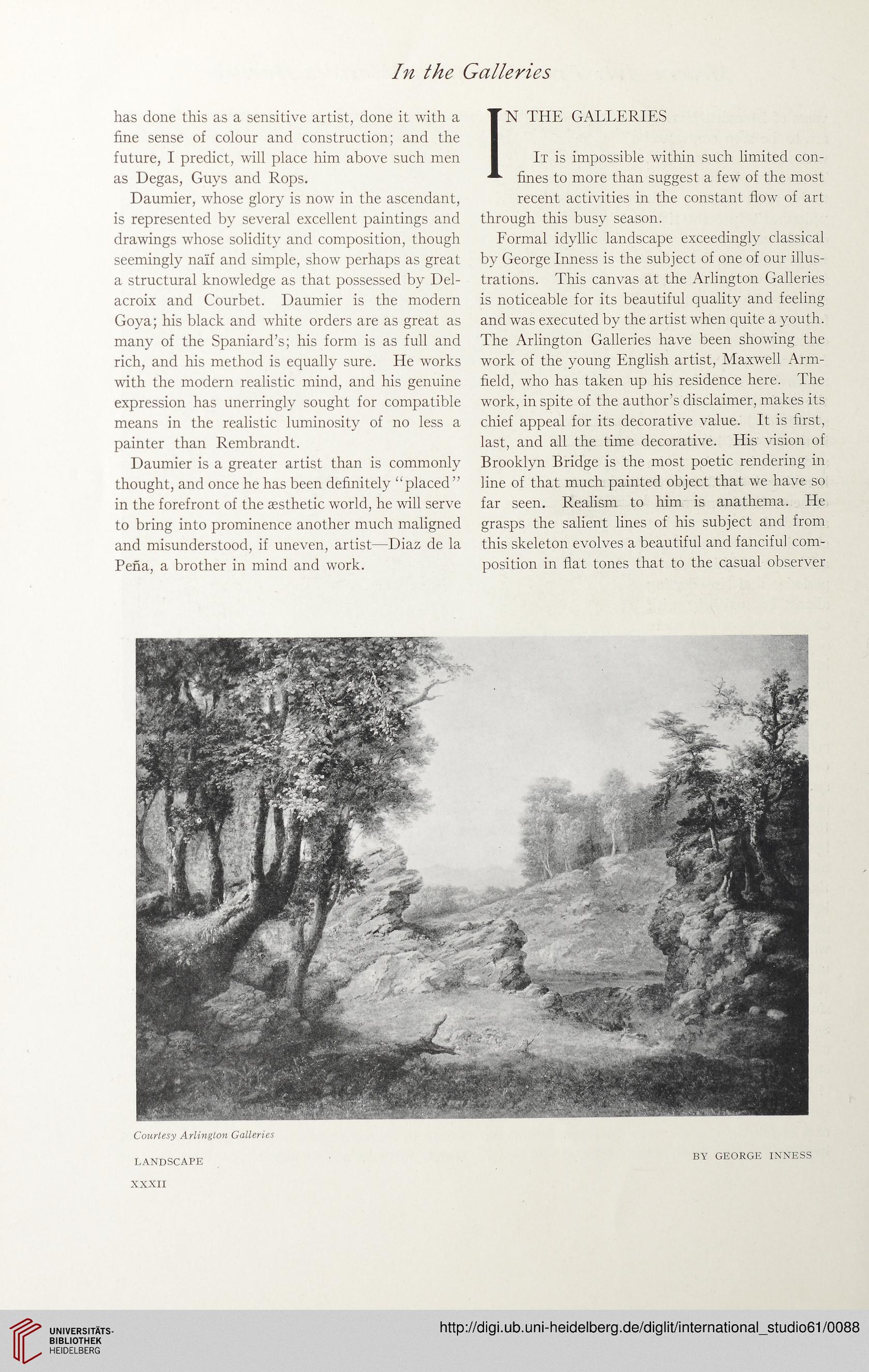In the Galleries
has done this as a sensitive artist, done it with a
fine sense of colour and construction; and the
future, I predict, will place him above such men
as Degas, Guys and Rops.
Daumier, whose glory is now in the ascendant,
is represented by several excellent paintings and
drawings whose solidity and composition, though
seemingly naif and simple, show perhaps as great
a structural knowledge as that possessed by Del-
acroix and Courbet. Daumier is the modern
Goya; his black and white orders are as great as
many of the Spaniard’s; his form is as full and
rich, and his method is equally sure. He works
with the modern realistic mind, and his genuine
expression has unerringly sought for compatible
means in the realistic luminosity of no less a
painter than Rembrandt.
Daumier is a greater artist than is commonly
thought, and once he has been definitely “placed”
in the forefront of the aesthetic world, he will serve
to bring into prominence another much maligned
and misunderstood, if uneven, artist—Diaz de la
Pena, a brother in mind and work.
IN THE GALLERIES
It is impossible within such limited con-
fines to more than suggest a few of the most
recent activities in the constant flow of art
through this busy season.
Formal idyllic landscape exceedingly classical
by George Inness is the subject of one of our illus-
trations. This canvas at the Arlington Galleries
is noticeable for its beautiful quality and feeling
and was executed by the artist when quite a youth.
The Arlington Galleries have been showing the
work of the young English artist, Maxwell Arm-
field, who has taken up his residence here. The
work, in spite of the author’s disclaimer, makes its
chief appeal for its decorative value. It is first,
last, and all the time decorative. His vision of
Brooklyn Bridge is the most poetic rendering in
line of that much painted object that we have so
far seen. Realism to him is anathema. He
grasps the salient lines of his subject and from
this skeleton evolves a beautiful and fanciful com-
position in flat tones that to the casual observer
Courtesy Arlington Galleries
LANDSCAPE
BY GEORGE INNESS
XXXII
has done this as a sensitive artist, done it with a
fine sense of colour and construction; and the
future, I predict, will place him above such men
as Degas, Guys and Rops.
Daumier, whose glory is now in the ascendant,
is represented by several excellent paintings and
drawings whose solidity and composition, though
seemingly naif and simple, show perhaps as great
a structural knowledge as that possessed by Del-
acroix and Courbet. Daumier is the modern
Goya; his black and white orders are as great as
many of the Spaniard’s; his form is as full and
rich, and his method is equally sure. He works
with the modern realistic mind, and his genuine
expression has unerringly sought for compatible
means in the realistic luminosity of no less a
painter than Rembrandt.
Daumier is a greater artist than is commonly
thought, and once he has been definitely “placed”
in the forefront of the aesthetic world, he will serve
to bring into prominence another much maligned
and misunderstood, if uneven, artist—Diaz de la
Pena, a brother in mind and work.
IN THE GALLERIES
It is impossible within such limited con-
fines to more than suggest a few of the most
recent activities in the constant flow of art
through this busy season.
Formal idyllic landscape exceedingly classical
by George Inness is the subject of one of our illus-
trations. This canvas at the Arlington Galleries
is noticeable for its beautiful quality and feeling
and was executed by the artist when quite a youth.
The Arlington Galleries have been showing the
work of the young English artist, Maxwell Arm-
field, who has taken up his residence here. The
work, in spite of the author’s disclaimer, makes its
chief appeal for its decorative value. It is first,
last, and all the time decorative. His vision of
Brooklyn Bridge is the most poetic rendering in
line of that much painted object that we have so
far seen. Realism to him is anathema. He
grasps the salient lines of his subject and from
this skeleton evolves a beautiful and fanciful com-
position in flat tones that to the casual observer
Courtesy Arlington Galleries
LANDSCAPE
BY GEORGE INNESS
XXXII




